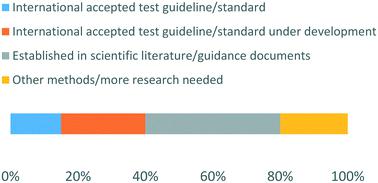当前位置:
X-MOL 学术
›
Environ. Sci.: Nano
›
论文详情
Our official English website, www.x-mol.net, welcomes your
feedback! (Note: you will need to create a separate account there.)
Nanomaterials in the European chemicals legislation – methodological challenges for registration and environmental safety assessment
Environmental Science: Nano ( IF 5.8 ) Pub Date : 2021-2-8 , DOI: 10.1039/d0en01123a Maria Bille Nielsen 1, 2, 3, 4 , Anders Baun 1, 2, 3, 4 , Aiga Mackevica 1, 2, 3, 4 , Amalie Thit 4, 5, 6, 7 , Inger Odnevall Wallinder 8, 9, 10, 11, 12 , Julián Alberto Gallego 12, 13, 14, 15, 16 , Lauge Peter Westergaard Clausen 1, 2, 3, 4 , Jenny Rissler 12, 17, 18, 19, 20 , Lars Skjolding 1, 2, 3, 4 , Alejandra Castro Nilsson 12, 21, 22 , Tommy Cedervall 12, 18, 23, 24 , Steffen Foss Hansen 1, 2, 3, 4
Environmental Science: Nano ( IF 5.8 ) Pub Date : 2021-2-8 , DOI: 10.1039/d0en01123a Maria Bille Nielsen 1, 2, 3, 4 , Anders Baun 1, 2, 3, 4 , Aiga Mackevica 1, 2, 3, 4 , Amalie Thit 4, 5, 6, 7 , Inger Odnevall Wallinder 8, 9, 10, 11, 12 , Julián Alberto Gallego 12, 13, 14, 15, 16 , Lauge Peter Westergaard Clausen 1, 2, 3, 4 , Jenny Rissler 12, 17, 18, 19, 20 , Lars Skjolding 1, 2, 3, 4 , Alejandra Castro Nilsson 12, 21, 22 , Tommy Cedervall 12, 18, 23, 24 , Steffen Foss Hansen 1, 2, 3, 4
Affiliation

|
In the European Union the Annexes of its chemical legislation (REACH) were revised and now clarify the technical data requirements for nanomaterials (NMs). These new provisions, effective from January 1, 2020, introduce requirements for manufacturers, importers and downstream users regarding registration and safety assessment of NMs. This study aims to assess the availability and suitability of methods needed to comply with the new regulatory provisions on NMs for physico-chemical characterisation and environmental fate and effects. The scientific literature and relevant test guideline frameworks were reviewed to identify applicable methods. These were subsequently evaluated and categorised as either: ‘internationally accepted test guideline or standard (TGS)’, ‘internationally accepted test guideline or standard under development (TGSUD)’, ‘established as standard methods in scientific literature (SCI)’, ‘other methods and/or more research needed (O)’ or ‘no method (N)’. We find that 80% of the information requirements and a bit more than 40% of the waiving criteria in the new REACH Annexes are supported by methods that are available as TGS, TGSUD or SCI. Most of the relevant methods in the scientific literature are included in recent OECD guidance documents or ECHA guidance. We recommend that a targeted effort is made to develop protocols and guidelines for methods to determine NM adsorption/desorption, degradation, exposure scenarios and ability to cross biological membranes. Here methods to fulfil the information requirements and waiving criteria are currently lacking. Furthermore, we recommend that increasing attention is directed towards regulatory reliability and relevance of the information that is submitted by the registrants.
中文翻译:

欧洲化学品立法中的纳米材料–注册和环境安全评估的方法挑战
在欧洲联盟,修订了其化学法规(REACH)的附件,现在阐明了纳米材料(NMs)的技术数据要求。这些新规定自2020年1月1日起生效,对制造商,进口商和下游用户提出了有关NM注册和安全评估的要求。这项研究的目的是评估符合有关NMs的新法规规定的理化特性和环境命运及影响所需方法的可用性和适用性。审查了科学文献和相关的测试指南框架,以确定适用的方法。随后对这些内容进行了评估并归类为:“国际公认的测试准则或标准(TGS)”,“国际公认的测试准则或正在开发的标准(TGSUD)”,“建立为科学文献中的标准方法(SCI)”,“其他方法和/或需要更多研究的方法(O)”或“无方法(N)”。我们发现,新的REACH附件中80%的信息要求和40%以上的豁免标准受到TGS,TGSUD或SCI等方法的支持。科学文献中的大多数相关方法都包含在最新的OECD指南文件或ECHA指南中。我们建议做出有针对性的努力,以开发用于确定NM吸附/解吸,降解,暴露场景和穿过生物膜的能力的方法的协议和指南。目前,这里缺少满足信息要求和放弃标准的方法。此外,
更新日期:2021-02-18
中文翻译:

欧洲化学品立法中的纳米材料–注册和环境安全评估的方法挑战
在欧洲联盟,修订了其化学法规(REACH)的附件,现在阐明了纳米材料(NMs)的技术数据要求。这些新规定自2020年1月1日起生效,对制造商,进口商和下游用户提出了有关NM注册和安全评估的要求。这项研究的目的是评估符合有关NMs的新法规规定的理化特性和环境命运及影响所需方法的可用性和适用性。审查了科学文献和相关的测试指南框架,以确定适用的方法。随后对这些内容进行了评估并归类为:“国际公认的测试准则或标准(TGS)”,“国际公认的测试准则或正在开发的标准(TGSUD)”,“建立为科学文献中的标准方法(SCI)”,“其他方法和/或需要更多研究的方法(O)”或“无方法(N)”。我们发现,新的REACH附件中80%的信息要求和40%以上的豁免标准受到TGS,TGSUD或SCI等方法的支持。科学文献中的大多数相关方法都包含在最新的OECD指南文件或ECHA指南中。我们建议做出有针对性的努力,以开发用于确定NM吸附/解吸,降解,暴露场景和穿过生物膜的能力的方法的协议和指南。目前,这里缺少满足信息要求和放弃标准的方法。此外,











































 京公网安备 11010802027423号
京公网安备 11010802027423号